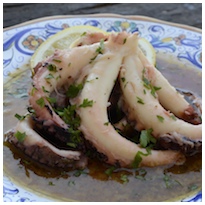 Serves 4
Serves 42 lbs. octopus
2/3 lb. mature tomatoes
1 garlic clove
parsley
chili pepper
1/2 cup white wine
olive oil
salt
pepper
Preparation:
1. Clean the octopus, removing the intestines, eyes, and beak.
2. Wash, dry, and chop into 1 1/2 inch pieces.
3. In a pan, saute the garlic, pepper and parsley in 8 tbs. of olive oil.
4. While the garlic browns, add the octopus and after a few minutes add the wine.
5. When it evaporates, add the tomatoes (after they have been peeled and chopped), salt, and pepper and cook on low heat for about one hour.
Serve warm.





